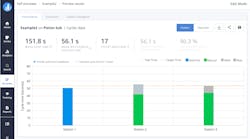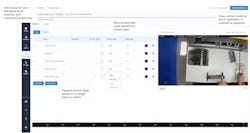Getting visibility into manufacturing operations can bring new insights into how work is being done and potential areas for improvement. This is the goal of Drishti, a company which combines artificial intelligence (AI) and video to create information which manufacturers can use to help improve training, productivity, and their overall operations.
Combining AI and video allows Drishti to provide customers with a live view into their manufacturing facilities from any location. “What this does is let us create information,” says Prasad Akella, founder of Drishti. “That's what Drishti is all about, creating information that lets [everyone]—from the person on the line to the plant manager to the CFO—execute at a different level.”
While data has always been available from machines, there has not been much available from manual lines since Henry Ford, says Akella. “And that’s a big gap because the bulk of manufacturing is done by people.
“We’re focusing on this big area that’s been avoided for 100 years, and bringing light to it,” he says.
In this Q&A with Power & Motion, Akella explains how Drishti is using AI and what is possible when bringing it together with video.
Editor’s note: Questions and responses have been edited for grammar and clarity.
Power & Motion (P&M): How is the company using AI to help improve manufacturing operations?
Prasad Akella (PA): If you look at the world of computer vision, what we're very good at is looking at an image and seeing what's going on in the image. And we've gotten better at it with neural networks coming in and AI coming in. When I started as a grad student years ago, you'd literally look at every little line…and you’d piece the whole thing together. Now AI lets us do that on the fly.
What is different about Drishti is we look at video. And looking at video means you're looking at spatial temporal information. So, things are moving in the image and you're extracting information from that moving image. That is what is fundamentally different about what Drishti does. What that lets us do is….really, without that AI, there's no Drishti. Because if I couldn't figure out what's going on in an image, there's nothing I can do after that.
We are using AI uniquely [and] the technology is proprietary…[and allows] us to provide insight and information to our users.
There's another level of AI—one most AI companies talk about today—which is using AI on data to start making predictions. I'll give an example. On the production line, I can actually see how many units are being built. If I have a sense of how many units are being built per hour, I can project how many will be done by the end of the shift. But what if I can tell the [shift workers] 2 hours in that I think they are going to need 45 minutes of overtime [to meet the shift’s units-built goal]? Then employees can tell their families they’re going to be running an hour late or the management team can decide if they should create a shift for the weekend. [This information] now suddenly lets you run your business and your life in a completely different way. The next level up from all of this is when you first create the data, which didn't exist before, and then you start mining the data to drive business processes. That's where AI fits into Drishti.
P&M: How has Drishti developed and implemented AI in its technology?
PA: Most people in the world of AI download neural network models that other companies have created, and then they train it, applying their problem by giving it examples of marked up data and take the result to do whatever they are doing. Nothing existed when we started the company for video. We've created all of that from scratch. Almost all of the AI that you see in Drishti is created by the company for our customers.
We deliver this as a service, so our customers don't need to [expend a lot of effort or] hire data scientists. We are delivering them a service much like Google is delivering you a service when you type in a keyword, Google does all the work, [and] all you get are the results. It's the same thing [with Drishti], we do all the work for the customer and deliver the results to them.
P&M: How do you foresee use of AI in manufacturing or other applications?
PA: Video has the ability to completely transform how we build systems. When I look at Power & Motion, I think of internal combustion engines, and I look at battery electric cars and think about the transition that industry is going through right now. [There is a] body of knowledge from the [locomotive industry on how to make this transition], so how do we take some of that knowledge and transfer it to the automotive world? And how do we help this entire cadre of people who know how to build internal combustion engines—whether it's an engineer or it's a line associate—how do we transform them so they can actually build these at scale?
Perhaps there's a role for AI and video to teach us because video doesn't need language, the human can interpret video without any translation. I think there's a very powerful series of things we can do in different verticals such as in the automotive discrete manufacturing vertical for the transition from internal combustion to EVs (electric vehicles).
And then in a completely different direction, you can think of safety. Whether it's on the plant floor or making burgers or in the operating theatre, how do I help with some form of feedback driven by video. There are several companies out there today that actually do this. If you're nodding off while you're driving, [their technology notices] and wakes you up. In other situations, how do you use video to make that possible, [which adds] a completely different dimension to this problem. So, if you think of it as a human dimension and as a technology dimension, and you're helping people in the middle, then suddenly there’s a whole space of problems you can solve.
The way I think about Drishti is, Google pioneered text, they monetized ads. But they gave us search. And they've changed the way we do everything, I search now, I don't use a file name, I simply search. They've changed how we think about it. And same thing if you think about Siri, and Apple, they introduced the notion of an assistant. I talk to it, [and] that now suddenly changes the interface. It's no longer a keyboard interface.
I think of Drishti’s work in video in that same sort of progression where now video becomes the interface, video becomes a source of power because there's so much information embedded in video. I think that's where AI is probably headed and how it will help people, empower people as you go along.



